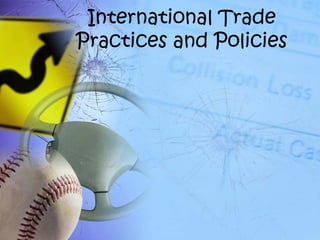
Chap. 12. international trade practices and policies
- 1. International Trade Practices and Policies
- 2. The Need for Trade • If we look around us, we will see many items we use which are imported from abroad or which have components imported abroad.
- 3. The Barangay economy – Barangay is a self sufficient economic unit living on substinence agriculture. The need of the barangay is very limited, production for a surplus is unnecessary.
- 4. The Manorial system • Economic and social system of medieval Europe under which peasants' land tenure and production were regulated, and local justice and taxation were administered.
- 5. Is there a “World Economy”? • With the growing interdependence of nations, a “world economy” started to exist. Through time, this interdependence has become more and more pronounced.
- 6. Trade as a “Primary instrument of development” • Trade is called a “primary instrument of development” because this has been its proven role throughout history. Trade became even more important for several reasons.
- 7. Mercantilism • Mercantilism is a political- economic movement originating in the period 1500-1750 whose paramount goal of national policy is to make the nation rich and powerful the means of which consisted mainly in the protection of domestic industry and the regulation of trade.
- 8. What is Trade? • A basic economic concept that involves multiple parties participating in the voluntary negotiation and then the exchange of one's goods and services for desired goods and services that someone else possesses.
- 9. What is International Trade? • Is the process of exchanging goods and services between countries. It involves the buying and selling of imports and exports.
- 10. Theory of Absolute Advantage • A country has an absolute advantage over another if it can produce, with a given amount of capital and labor, a larger output than its rival Or in other words to produce more of a good or service than competitors, using the same amount of resources.
- 11. Country A can produce 1000 parts per hour with 200 workers. Country B can produce 2500 parts per hour with 200 workers. Country C can produce 10000 parts per hour with 200 workers.
- 12. Theory of Comparative Cost (advantage) • Nations should specialize in the production of goods in which they have comparative advantage and import those products of which it has the least advantage.
- 13. Cloth Wine Britain 100 110 Portugal 90 80 it is efficient for Britain to produce cloth, and Portugal to produce wine, as, assuming that these trade at equal price (1 unit of cloth for 1 unit of wine) Britain can then obtain wine at a cost of 100 labor units by producing cloth and trading, rather than 110 units by producing the wine itself, and Portugal can obtain cloth at a cost of 80 units by trade rather than 90 by production.
- 14. Trade practices and policies • Philippine exports have been the main dollar earner of the country. In recent years, it has contributed about fifty percent of total dollar receipts of the country.
- 15. Exports • are goods or merchandise that we sell to other countries to earn dollars. These dollars that we earn will later be used to buy goods we need from abroad.
- 16. Other sources of dollars • Dollars from gold • Dollars from invisibles
- 17. Imports • The dollars we earn through exports and other sources are used mainly to import goods and services we need. Most of our imports are composed of industrial and manufactured items.
- 18. Balance of payments • Our balance of payments is considered favorable if dollar inflows or receipts exceed outflows or payments.
- 19. Balance of trade • The balance of trade is called favorable if exports exceed imports. • The balance of trade is called unfavorable if imports exceed exports.
